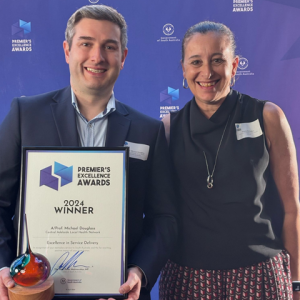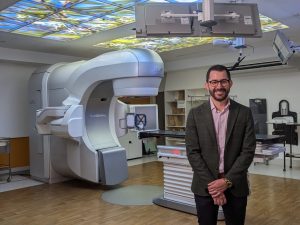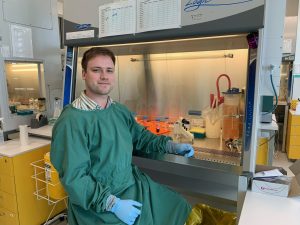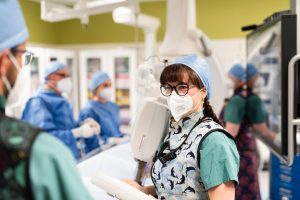The radiation oncology unit at the Royal Adelaide Hospital (RAH) might seem like a place of complex machines and intimidating procedures. But for Associate Professor Michael Douglass, Principal Medical Physicist at RAH, it’s a space of innovation, creativity, and even beauty. Fresh from his win in the Excellence in Service Delivery category for the 2024 Premier’s Excellence Awards, Dr Douglass has a goal to make what he does more accessible and understandable to patients.
“Radiation therapy can be overwhelming, but when patients understand the process, it can ease anxiety and often leads to better outcomes.”
Dr Douglass’s passion for clarity and compassion in cancer treatment shines through not only in the advanced technologies being deployed at RAH but also in unexpected places, like an art gallery.

A/Professor Michael Douglass with CALHN CEO Emma McCahon
Turning radiation into art
Among the most surprising aspects of Douglass’s work is an art initiative that transforms radiation therapy into a visual wonder. Using decommissioned medical equipment, Douglass and his team have created both physical and computer-generated artwork that resembles trees, dubbed the Trees of Life.
“At the end of life of some of our equipment, we modify it slightly enabling us to deliver the radiation into plastic blocks to create these beautiful, branching patterns, like trees,” he says.
“It’s become something of a tradition to give these machines a final send-off this way. It’s a reminder that even something as technical and serious as radiation therapy has beauty behind it.”
The project was taken a step further with an exhibition for The Hospital Research Foundation, where Douglass wrote some computer code to simulate these trees digitally and turned them into stunning visual pieces. Some of these artworks are now on display in the RAH’s radiotherapy department, a calming and fascinating sight for patients waiting for treatment.
Innovation at the core
Beyond the art, the RAH medical physics team is at the forefront of transforming the treatment process itself. A standout example is a recent alternative to the traditional brachytherapy used for prostate cancer.
“Brachytherapy is very effective, but demand has created long wait times. We’ve developed a treatment with equivalent outcomes and fewer logistical hurdles,” Douglass says.
This new approach avoids general anaesthesia and complex surgical procedures.
“Instead of radioactive sources surgically implanted into the prostate, we use gold markers and deliver the radiation externally over five short sessions. It’s quicker, less invasive, and patients can access it within a few weeks, rather than waiting a few months.”
AI to the rescue
One of the most time-consuming aspects of radiation therapy has been treatment planning, specifically the manual drawing of organs and tumours on each CT scan. Dr Douglass and his team have introduced AI tools to reduce the time it takes to perform this step.
“For each patient, you need to individually outline all relevant organs and structures, it could take a doctor over an hour. With AI, that’s down to just a few minutes, with minimal corrections,” he explains.
The AI models, trained on thousands of prior scans, are now part of everyday workflow, saving clinicians time and reducing waiting times while improving the standard and consistency of care for our patients.
Better understanding = better outcomes
Douglass is particularly driven by a recent study that demonstrated how patients who were given the choice to learn more about the technical details of their treatment reported less anxiety and improved reported clinical outcomes.
“That research really resonated with me,” he says. “So, I started looking at ways to help patients engage more with what’s happening during their treatment. For example, turning medical CT scans into relatable 3D-coloured images so they can ‘see’ their own anatomy more clearly. It helps people feel like they’re part of the process, not just subjects of it.”
Mentoring the next generation
In addition to his clinical work, Dr Douglass mentors postgraduate students from both the University of Adelaide and the University of South Australia. Many of his former students are now colleagues at RAH, helping advance the same mission of better, more compassionate care.
“There are 17 medical physicists in our department now, and around 25 across the public sector here. It’s a close-knit field, but one that’s evolving quickly—and we want to make sure the next generation is ready to lead.”
Through his technical mastery, mentorship, and a touch of artistic vision, Associate Professor Michael Douglass is helping reshape the experience of cancer treatment at the Royal Adelaide Hospital—making it not only more efficient and effective but also a little more human.



